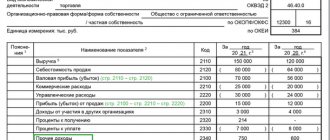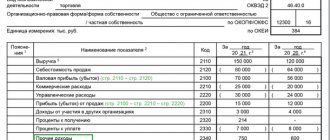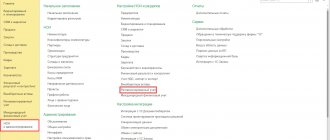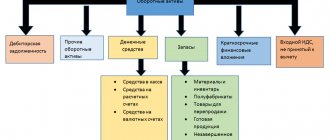Financial reporting forms
There are 4 forms of financial (accounting) reporting :
Take our proprietary course on choosing stocks on the stock market → training course
- Balance sheet (it groups the assets and liabilities of the organization).
- Financial results report (the report presents data on the organization's income).
- Report on changes in capital (the report provides information on the movement of authorized, reserve and additional capital).
- Cash Flow Statement (the report displays information about cash flows).
The most used in the practice of financial analysis are the first two forms: Balance Sheet and Statement of Financial Results
Take our proprietary course on choosing stocks on the stock market → training course
| Business valuation | Financial analysis according to IFRS | Financial analysis according to RAS |
| Calculation of NPV, IRR in Excel | Valuation of stocks and bonds |
Changes in the form of the balance sheet
The main trend in the development of the balance sheet in Russia in recent years is the simplification of its structure. The most recent changes were made to the balance sheet by order of the Ministry of Finance of Russia dated July 2, 2010 N 66n “On forms of financial statements of organizations” (as amended by orders of the Ministry of Finance of Russia dated October 5, 2011 No. 124n, dated August 17, 2012 No. 113n and dated 04.12.2012 No. 154n).
Unlike the previous order on reporting forms (Order of the Ministry of Finance of Russia dated July 22, 2003 No. 67n), the forms approved by the new order (in particular, the balance sheet) are not samples on the basis of which enterprises develop their forms. Now it is necessary to provide the forms exactly in the form in which they are approved by the order. However, it should be noted that enterprises have the right to independently detail the indicators for reporting items.
It should be noted that the new order cancels the numbering of reporting forms. Officially, reporting forms now need to be named in detail. Also, the coding of lines in the balance sheet is now mandatory only when submitting financial statements to state statistics bodies and other executive authorities. A certificate confirming the presence of valuables recorded in off-balance sheet accounts is excluded from the balance sheet form. In addition, a column “Explanations” appeared in front of the item indicators, which indicates the number of the corresponding explanation to the balance sheet [5, p. 12].
The new form of the balance sheet reflects information over three consecutive years: as of the reporting date of the current period and as of December 31 of the two years preceding the reporting period.
In Section I “Non-current assets” of the balance sheet, a part of the assets that was previously reflected in the article “Intangible assets” is allocated to a separate article “Results of Research and Development”. Now, this new item indicates the amount of expenses for R&D, reflected in account 04 and which is not written off as expenses for ordinary activities or other expenses as of the reporting date [2, p. 45].
Also, two articles have been added to Section I - “Intangible Search Assets” and “Tangible Search Assets”. According to clause 27 of the Accounting Regulations “Accounting for the costs of developing natural resources”, approved by order of the Ministry of Finance of the Russian Federation dated October 6, 2011 No. 125n (PBU 24/2011), significant information about the costs of developing natural resources (subsoil), recognized as non-current assets are reflected on a separate line in the balance sheet. The enterprise classifies all other search costs as expenses for ordinary activities.
In Section I of the new balance sheet there is no article “Construction in progress”, which contained the balances of accounts 07 “Equipment for installation”; 08 subaccounts 1 “Purchase of land plots”, 2 “Purchase of environmental management facilities”, 3 “Construction of fixed assets”, 4 “Purchase of fixed assets”. Some experts recommend reflecting these amounts as part of the item “Other non-current assets”. However, this is not entirely correct, since information on capital investments can hardly be called insignificant [4]. To resolve this issue, you must refer to clause 20 of PBU 4/99. There is a table with balance indicators. In the table in the group of articles “Fixed assets”, among the transcripts there is “Construction in progress”. Consequently, incomplete capital investments should be reflected in the item “Fixed assets”.
It should be emphasized that in this section of the new form the indicator “Long-term financial investments” has been renamed “Financial investments”.
There have also been significant changes in section II “Current assets” of the balance sheet. Thus, the “Inventories” indicator in the new balance sheet form is reflected in a general way, without decoding. Organizations independently determine the details of this indicator.
In Section II of the new accounts receivable balance sheet, only one article is devoted to “Accounts receivable”. In this regard, when reflecting the amounts of receivables, it is necessary to take into account several nuances. Firstly, regarding advances and prepayments. According to documents of the Ministry of Finance of Russia, in the case of issuing advances and prepayments for work and services that are associated, for example, with the construction of fixed assets, these amounts are reflected in the balance sheet in Section I “Non-current assets” [1]. It also states that this procedure for displaying advances on the balance sheet does not depend on the maturity date of obligations on advances issued (prepayments).
Secondly, in relation to settlements with buyers and customers. According to paragraph 19 of PBU 4/99, assets whose circulation period is within the operating cycle exceeding 12 months are classified as short-term. A typical example of such assets is trade receivables. This debt is permanently part of the operating cycle, therefore it is shown in the balance sheet as part of current assets. In addition, it does not matter whether or not the payment period provided for in the contract exceeds 12 months after the reporting date.
Other types of receivables should be qualified in accordance with the requirements of clause 19 of PBU 4/99. Consequently, such receivables will be recorded as current assets if their maturity is less than 12 months after the reporting date. If the repayment period for other types of receivables exceeds 12 months after the reporting date, then these amounts are indicated as non-current assets.
In section II of the balance sheet “Current assets”, the names of several lines were changed: “Short-term financial investments” were replaced by “Financial investments”, and then “Financial investments (except for cash equivalents)”, and the line “Cash” is now called “Cash and cash equivalents." These changes are related to the introduction of the Accounting Regulations “Cash Flow Statement”, approved by Order of the Ministry of Finance of Russia dated 02.02.2011 No. 11n (PBU 23/2011).
The changes also affected section III of the balance sheet “Capital and reserves”. Firstly, the name of the article “Authorized capital” has been clarified - in the new form it is called “Authorized capital (share capital, authorized capital, contributions of partners)”.
Secondly, if in the old form of the balance sheet additional capital was shown in one line - “Additional capital”, then in the new form it is taken into account using two independent items - “Revaluation of non-current assets” and “Additional capital (without revaluation)”. The first article takes into account the amount of increase in the value of non-current assets identified as a result of their revaluation. The second article shows additional capital formed, for example, due to:
— share premium, which is the positive difference between the sale and par value of shares received in the process of forming the authorized capital;
— exchange rate differences associated with settlements with founders on deposits, including contributions to the authorized (share) capital of the organization, expressed in foreign currency.
It should also be noted that reserve capital in the new form of balance sheet is reflected in general terms, without decoding. The line “Reserve capital” shows the total amount of reserve capital of the enterprise formed both in accordance with the legislation of the Russian Federation and in accordance with the constituent documents.
Let's look at the changes that have occurred in sections IV “Long-term liabilities” and V “Short-term liabilities”. First, in both sections the lines “Loans and credits” have been renamed to “Borrowed funds”. Second, the lines “Other long-term liabilities” in Section IV and “Other current liabilities” in Section V have been renamed “Other Liabilities.”
Particular attention should be paid to estimated liabilities. Since January 1, 2011, the Accounting Regulations “Estimated Liabilities, Contingent Liabilities and Contingent Assets” have been in effect, which was approved by Order of the Ministry of Finance of Russia dated December 13, 2010 No. 167n (PBU 8/2010).
By Order No. 66n, the article “Reserves for contingent liabilities” was introduced into section IV of the balance sheet. This name corresponded to the previous edition of PBU 8/01, which provided for the display of amounts of existing contingent liabilities in accounting and reporting. But, in accordance with the new edition of PBU 8/2010, this indicator is not reflected in accounting and reporting.
In addition, in Section V “Short-term liabilities” there was an item “Reserves for future expenses”. However, starting from January 1, 2011, reserves for future expenses are not formed in accounting. The possibility of forming such reserves was provided for in clause 72 of the Regulations on accounting and financial reporting in the Russian Federation. But on the basis of the order of the Ministry of Finance of Russia dated December 24, 2010 No. 186n, clause 72 was excluded from the Regulations.
At the same time, special lines were not provided in the liabilities side of the balance sheet to reflect estimated liabilities.
In order to bring the balance sheet figures into line with the changes that occurred in accounting, by Order of the Ministry of Finance No. 124n the names of two lines in the balance sheet were replaced - “Reserves for contingent liabilities” in section IV and “Reserves for future expenses” in section V with “Estimated liabilities” [3].
Section V of the new balance sheet form “Short-term liabilities” does not contain the article “Debt to participants (founders) for payment of income.” The amounts of this debt are reflected in the new balance sheet under the item “Accounts Payable” in Section V. It should also be emphasized that the item “Accounts Payable” shows summary data on the total amount of accounts payable with a maturity of less than 12 months without breakdown by type of debt, as was the case previously. However, organizations have the right to independently determine the details of this article.
The changes that affected accounting reporting, and in particular the balance sheet, have both their opponents and their supporters. Opponents argue that the balance sheet is becoming less and less informative, and this has a negative impact on the determination and analysis of the financial position of the organization. Supporters of the changes believe that the balance was overly detailed and contained items that were not so useful and necessary for users of information. Now, some items are shown enlarged, the balance sheet has become more compact, and organizations, if the information is significant, can detail the balance sheet items. The position of the supporters is more justified, since in the new form of the balance sheet only that information will be detailed, without knowledge of which it will be impossible to assess the financial position of the organization; and non-essential information will be shown enlarged.
Literature:
1. On reflecting in the balance sheet the amount of advances issued and prepayment for work and services [Electronic resource]: letter of the Ministry of Finance of the Russian Federation dated April 11, 2011, No. 07–02–06/42 // Reference and legal system “Consultant Plus”.
2. Bashkatova L. I. New format of the balance sheet // Accounting. - 2012. - No. 2. - p. 44–50.
3. Dyachkova O.A Forms of accounting reports: current and future changes [Electronic resource]: Practical accounting. Official materials and comments. — 2012. — No. 2 // Legal reference system “Consultant Plus”.
4. Polyakova M. S. Annual reports for 2011: formation of the balance sheet and explanations [Electronic resource]: Russian tax courier. — 2012. — No. 1–2 // Legal reference system “Consultant Plus”.
5. Fomicheva L.P. Accounting statements according to new forms // Accounting. - 2011. - No. 1. - p. 11–20.
Where can I find financial reporting forms for business?
By law, all enterprises that issue shares must disclose their information (in accordance with the requirements of paragraph 1.7. “Regulations on the disclosure of information by issuers of equity securities”, approved by Order of the Federal Service for Financial Markets of the Russian Federation dated October 4, 2011 No. 11-46 /pz-n). All financial statements of joint stock companies can now be viewed.
Public reporting means that it is publicly available to all users. For example, on enterprise websites you can see the “Information Disclosure” section and there, as a rule, there is a “Shareholders and Investors” tab. It will contain the financial results of the year or financial reports by quarter.
The figure below, on the website of JSC Tupolev, shows the financial statements of the enterprise for 2013. There are 4 forms of financial reporting. An audit report is a fact of verification by an independent body of financial statements. There's no point in watching it for us. We also don’t really need explanations for the balance sheet to carry out financial analysis.
Forms of financial (accounting) statements of JSC Tupolev on the company website
Let's get acquainted with the balance sheet items for 2017–2018: their codes and explanations
Everyone who has ever held a balance sheet in their hands, much less drawn it up, paid attention to the “Code” column.
Thanks to this column, statistical authorities are able to systematize the information contained in the balance sheets of all companies. Therefore, it is necessary to indicate codes in the balance sheet only when this report is submitted to state statistics bodies and other executive authorities (Article 18 of the Law “On Accounting” dated December 6, 2011 No. 402-FZ, clause 5 of the order of the Ministry of Finance of Russia dated July 2, 2010 No. 66n). If the balance is not annual and is needed only by owners or other users, it is not necessary to indicate the codes. In the balance sheet, line codes from 2014 must correspond to the codes specified in Appendix 4 to Order No. 66n. At the same time, outdated codes from the expired order No. 67n with the same name, dated July 22, 2003, are no longer applied.
It is not difficult to distinguish previously used codes from modern ones - by the number of digits: modern codes are 4-digit (for example, lines 1230, 1170 of the balance sheet), while outdated ones contained only 3 digits (for example, 700, 140).
For information on what the form of the current balance sheet with line codes looks like, read the article “Filling out Form 1 of the balance sheet (sample).”
Who needs business financial reporting forms? Types of financial statements
Let's take a look: who needs data from the financial reporting forms of an enterprise? As a rule, these are investors and shareholders . They use a company's financial statements to assess the return on investment of their investments. The table below presents all users of the enterprise's financial statements.
| Financial Statement User | Purpose of financial statement analysis |
| Investors and shareholders | Assessing the profitability of your investment in the enterprise |
| FTS (Federal Tax Service) | Assessment of an enterprise for its taxability |
| Counterparties | Assessing the partner’s financial condition |
| Banks | Enterprise assessment for issuing a loan |
| Arbitration court | To assess the fact of bankruptcy of an enterprise |
Take our proprietary course on choosing stocks on the stock market → training course
What has changed
Now we will consider in detail all the changes in the balance sheet form from 2022.
Adjusted the balance header
In the header part there is a book. The balance code of the OKUD form is now brought into compliance with the Decree of the State Standard of Russia dated December 30, 1993 No. 299 in the current version of the orders of Rosstandart.
The reference from activity codes according to OKVED to codes according to OKVED 2 has also been replaced.
Excluded the total indicator
Now in the balance sheet data can only be entered in “thousands”. rub.”, and in “million rubles.” - it is forbidden.
The fact is that the last indicator is excluded from the form. Note that until 2022 this indicator could be chosen.
The Federal Tax Service of Russia recommended the following machine-readable forms of financial statements:
- KND form 0710099 - who reports in the general manner;
- KND form 0710096 – who reports using simplified forms.
New line for audit
From 2022, a line has been added under the balance sheet to indicate the mandatory audit of annual reporting. This block looks like this:
If an audit is required for a company by law or internal rules, you need to check the appropriate box and provide information about the auditor.
KEEP IN MIND
Since the audit concerns only annual reporting, interim reporting in 2022 should always be marked o.
Transformation of the old form of financial reporting into a new one (after 2011)
After 2011, new forms of financial reporting appeared. It is often necessary to convert old forms of financial (accounting) reporting to new ones. Below is a table of translation (Forms No. 1 and Forms No. 2 into the new forms “Balance Sheet” and “Financial Results”). The old lines (designated by Order of the Ministry of Finance No. 66n) are matched with new lines (designated by Order of the Ministry of Finance No. 67n).
| Indicator name | Old codes (before 2011) | New codes (after 2011) |
| Intangible assets | 110 | 1110 |
| Fixed assets | 120 | 1130 |
| Construction in progress | 130 | |
| Profitable investments in material assets | 135 | 1140 |
| Long-term financial investments | 140 | 1150 |
| Deferred tax assets | 145 | 1160 |
| Other noncurrent assets | 150 | 1170 |
| FIXED ASSETS | 190 | 1100 |
| Reserves | 210 | 1210 |
| VAT on purchased assets | 220 | 1220 |
| Accounts receivable (more than a year) | 230 | |
| buyers and customers | 231 | |
| Accounts receivable (less than a year) | 240 | 1230 |
| buyers and customers | 241 | |
| Short-term financial investments | 250 | 1240 |
| Cash | 260 | 1250 |
| Other current assets | 270 | 1260 |
| CURRENT ASSETS | 290 | 1200 |
| ASSETS total | 300 | 1600 |
| Authorized capital | 410 | 1310 |
| Extra capital | 420 | 1350+1340 |
| Reserve capital | 430 | 1360 |
| reserves formed in accordance with legislation | 431 | |
| reserves formed in accordance with the establishment. documents | 432 | |
| Retained earnings (uncovered loss) | 470 | 1370 |
| CAPITAL AND RESERVES | 490 | 1300 |
| Loans and credits (long-term) | 510 | 1410 |
| Other long-term liabilities | 520 | 1450 |
| LONG TERM DUTIES | 590 | 1400 |
| Loans and credits (short-term) | 610 | 1510 |
| Accounts payable | 620 | 1520 |
| debt to the government off-budget funds | 625 | |
| Debt to participants (founders) for payment of income | 630 | |
| revenue of the future periods | 640 | 1530 |
| Reserves for upcoming expenses and payments | 650 | 1540+1430 |
| Other current liabilities | 660 | 1550 |
| SHORT-TERM LIABILITIES | 690 | 1500 |
| LIABILITIES total | 700 | 1700 |
| Sales proceeds (excluding VAT, excise taxes...) | 010 | 2110 |
| Cost of goods, products, works, services sold | 020 | 2120 |
| Gross profit | 029 | 2100 |
| Business expenses | 030 | 2210 |
| Administrative expenses | 040 | 2220 |
| Profit (loss) from sale | 050 | 2200 |
| Interest receivable | 060 | 2320 |
| Percentage to be paid | 070 | 2330 |
| Income from participation in other organizations | 080 | 2310 |
| Other income | 090 | 2340 |
| Other operating expenses | 100 | 2350 |
| Profit (loss) before tax | 140 | 2300 |
| Current income tax | 150 | 2410 |
| Net profit | 190 | 2400 |
Balance sheet: line 1150
In the balance sheet form approved by Order of the Ministry of Finance dated July 2, 2010 No. 66n, line 1150 is called “Fixed assets.”
As the name suggests, line 1150 as of the reporting date reflects the amount of the organization’s fixed assets. But here it is necessary to take into account several features.
Firstly, line 1150 does not take into account all fixed assets, but only those reflected in account 01 “Fixed assets” (Order of the Ministry of Finance dated October 31, 2000 No. 94n). Let us recall that fixed assets that are intended exclusively for provision by an organization for a fee for temporary possession or use for the purpose of generating income are accounted for in account 03 “Income-generating investments in material assets” (clause 5 of PBU 6/01, Order of the Ministry of Finance dated October 31, 2000 No. 94n). And they are reflected in the balance sheet on line 1160 “Profitable investments in material assets” (Order of the Ministry of Finance dated July 2, 2010 No. 66n).
Secondly, fixed assets in the balance sheet, like all other indicators, are reflected in a net valuation (clause 35 of PBU 4/99). In relation to fixed assets, this means that they are shown on line 1150 at their residual value.
As for accounting accounts, to fill out line 1150 you need to subtract from the debit balance of account 01 the credit balance of account 02 “Depreciation of fixed assets” for the same reporting date. Naturally, depreciation needs to be deducted only that which relates to fixed assets accounted for in account 01. After all, for profitable investments in material assets accounted for in account 03, depreciation is also accrued for account 02. And since the debit balance of account 03 is not included in line 1150 , then the depreciation related to them should also be excluded from the balance of account 02.
Source
Funds from the budget for capital expenditures are reflected in a new way
Since 2022, changes made to PBU 13/2000 “Accounting for State Aid” by order of the Ministry of Finance of Russia dated December 4, 2018 No. 248n are in effect.
Now, as a separate article in Sect. IV “Long-term liabilities” of the balance sheet can reflect deferred income recognized in accordance with paragraph. 2 clause 9 of PBU 13/2000 in connection with the receipt of budget funds to finance capital costs (subclause “a” of clause 21 of PBU 13/2000).
Information on such future income in line 1450 “Other liabilities” is not provided, even if their value is insignificant.
We note that the procedure adopted by the organization for presenting information about these incomes must be disclosed in the explanations to the financial statements (clause 22 of PBU 13/2000).
A new composition of balance sheet indicators has also been introduced, disclosing information about received government assistance. Here, in separate articles, taking into account materiality, they reflect:
• unused balance of provided budget funds as part of targeted financing; • accounts receivable for budget funds accepted for accounting; • accounts payable for the return of budget funds recognized in accounting; • deferred income, which the organization recognized as part of short-term liabilities when receiving government assistance for current expenses.
Let us note that until 2022, the organization showed the balance of provided budget funds under the item “Deferred income” or separately in the section “Short-term liabilities”.
On the balance sheet, deferred income recognized upon receipt of funds to finance capital expenditures can be reflected in one of two ways. How:
- a separate item as part of long-term liabilities;
- a regulatory value that reduces the book value of non-current assets.






